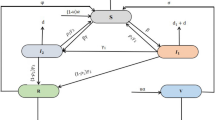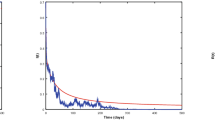Abstract
In this study, we propose a switching model with multi-thresholds, considering alternately trigger on/off enhanced control interventions (ECIs) following the evolution of the epidemic of emerging infectious diseases. Despite the high non-smoothness of the proposed model, we obtain the generalized formulations of the peak sizes of all the epidemic waves generated by the switching control, and also the final epidemic size as infections tend to zero after finite epidemic waves. We therefore provide the critical strength of control interventions to control the peak or final size below a target value. Furthermore, we analyze the impacts of four specific alternate control modes of the proposed model, namely persistent, one-shot, fixed-mode alternate and adaptive alternate control, on the final and maximum peak sizes, and further analyze the optimal thresholds in terms of minimizing four epidemic indexes, i.e. maximum peak size, final size, duration of control, and switching times. Our results reveal that to minimize the maximum peak size (or avoid the runs on medical resources), the key is to design optimal threshold conditions or switching mode to average all the infections into multiple epidemic waves. It seems hard to achieve the goal of simultaneously minimizing the four indexes. Alternatively, we consider to search the optimal thresholds in terms of one index with constrained conditions to other indexes, and conclude that the adaptive alternate control by adjusting the threshold conditions following the evolution of epidemic can be an excellent strategy.







Similar content being viewed by others
Availability of data and materials
Not applicable.
References
Kirtane, A.R., Verma, M., Karandikar, P., Furin, J., Langer, R., Traverso, G.: Nanotechnology approaches for global infectious diseases. Nat. Nanotechnol. 16, 369–384 (2021)
Aldridge, R.W., Nellums, L.B., Bartlett, S., Barr, A.L., Patel, P., Burns, R., Hargreaves, S., Miranda, J.J., Tollman, S., Friedland, J.S., Abubakar, I.: Global patterns of mortality in international migrants: a systematic review and meta-analysis. Lancet 392, 2553–2566 (2018)
Shi, T., Denouel, A., Tietjen, A.K., Campbell, I., Moran, E., Li, X., Campbell, H., Demont, C., Nyawanda, B.O., Chu, H.Y., Stoszek, S.K., Krishnan, A., Openshaw, P., Falsey, A.R., Nair, H.: RESCEU investigators: global disease burden estimates of respiratory syncytial virus-associated acute respiratory infection in older adults in 2015: a systematic review and meta-analysis. J. Infect. Dis. 222, S577–S583 (2020)
Bloom, D.E., Cadarette, D.: Infectious disease threats in the twenty-first century: strengthening the global response. Front. Immunol. 10, 549 (2019)
Baker, M.G., Wilson, N., Blakely, T.: Elimination could be the optimal response strategy for covid-19 and other emerging pandemic diseases. BMJ 371, m4907 (2020)
Shokoohi, M., Osooli, M., Stranges, S.: COVID-19 pandemic: what can the west learn from the east? Int. J. Health Policy Manag. 9(10), 436–438 (2020)
Pei, S., Kandula, P., Shaman, J.: Differential effects of intervention timing on COVID-19 spread in the United States. Sci. Adv. 6(49), eabd6370 (2020)
Davies, N.G., Kucharski, A.J., Eggo, R.M., Gimma, A., Edmunds, W.J.: Effects of non-pharmaceutical interventions on COVID-19 cases, deaths, and demand for hospital services in the UK: a modelling study. Lancet Public Health 5(7), e375–e385 (2020)
Koo, J.R., Cook, A.R., Park, M., Sun, Y.X.H., Sun, H.Y., Lim, J.T., Tam, C., Dickens, B.L.: Interventions to mitigate early spread of SARS-CoV-2 in Singapore: a modelling study. Lancet Infect. Dis. 20(6), 678–688 (2020)
Tang, B., Wang, X., Li, Q., Bragazzi, N.L., Tang, S.Y., Xiao, Y.N., Wu, J.H.: Estimation of the transmission risk of the 2019-nCoV and its implication for public health interventions. J. Clin. Med. 9(2), 462 (2020)
Li, W.J., Ji, J.C., Huang, L.H., Wang, J.F.: Bifurcations and dynamics of a plant disease system under non-smooth control strategy. Nonlinear Dyn. 99, 3351–3371 (2020)
Chang, S.L., Harding, N., Zachreson, C., Cliff, O.M., Prokopenko, M.: Modelling transmission and control of the COVID-19 pandemic in Australia. Nat. Commun. 11, 5710 (2020)
White, M.T., Walker, P., Karl, S., Hetzel, M.W., Freeman, T., Waltmann, A., Laman, M., Robinson, L.J., Ghani, A., Mueller, I.: Mathematical modelling of the impact of expanding levels of malaria control interventions on Plasmodium vivax. Nat. Commun. 9, 3300 (2018)
Tang, B., Xia, F., Tang, S.Y., Bragazzi, N.L., Li, Q., Sun, X.D., Liang, J.H., Xiao, Y.N., Wu, J.H.: The effectiveness of quarantine and isolation determine the trend of the COVID-19 epidemics in the final phase of the current outbreak in China. Int. J. Infect. Dis. 95, 288–293 (2020)
Tang, B., Xia, F., Bragazzi, N.L., McCarthy, Z., Wang, X., He, S., Sun, X.D., Tang, S.Y., Xiao, Y.N., Wu, J.H.: Lessons drawn from China and South Korea for managing COVID-19 epidemic: insights from a comparative modeling study. ISA Trans. 124, 164–175 (2022)
Tang, B., Zhou, W.K., Wang, X., Wu, H.L., Xiao, Y.N.: Controlling multiple COVID-19 epidemic waves: an insight from a multi-scale model linking the behaviour change dynamics to the disease transmission dynamics. Bull. Math. Biol. 84(10), 106 (2022)
Chowdhury, R., Heng, K., Shawon, M.S.R., Goh, G., Okonofua, D., Ochoa-Rosales, C., Gonzalez-Jaramillo, V., Bhuiya, A., Reidpath, D., Prathapan, S., Shahzad, S., Althaus, C.L., Gonzalez-Jaramillo, N., Franco, O.H.: Dynamic interventions to control COVID-19 pandemic: a multivariate prediction modelling study comparing 16 worldwide countries. Eur. J. Epidemiol. 35, 389–399 (2020)
Firth, J.A., Hellewell, J., Klepac, P., Kissler, S., Kucharski, A.J., Spurgin, L.G.: Using a real-world network to model localized COVID-19 control strategies. Nat. Med. 26, 1616–1622 (2020)
Lauro, F.D., Kiss, I.Z., Miller, J.C.: Optimal timing of one-shot interventions for epidemic control. PLoS Comput. Biol. 17(3), e1008763 (2021)
Dickens, B.L., Koo, J.R., Lim, J.T., Park, M., Quaye, S., Sun, H., Sun, Y., Pung, R., Wilder-Smith, A., Chai, L.Y.A., Lee, V.J., Cook, A.R.: Modelling lockdown and exit strategies for COVID-19 in Singapore. Lancet Region. Health Western Pacific 1, 100004 (2020)
Peto, J., Alwan, N.A., Godfrey, K.M., Burgess, R.A., Hunter, D.J., Riboli, E., Romer, P.: Universal weekly testing as the UK COVID-19 lockdown. Lancet 395, 1420–1421 (2020)
UK Parliament. Coronavirus: a history of English lockdown laws. Available at: https://commonslibrary.parliament.uk/research-briefings/cbp-9068/
Gautam, M., Yadav, D.S., Agrawal, S.B., Agrawal, M.: Socio-economic insinuations and air quality status in India due to COVID-19 pandemic lockdown. COVID-19 212, 83–112 (2021)
Kumar, S.: Effect of meteorological parameters on spread of COVID-19 in India and air quality during lockdown. Sci. Total Environ. 745(25), 141021 (2020)
Magal, P., Seydi, O., Webb, G.: Final size of an epidemic for a two-group SIR model. SIAM J. Appl. Math. 76(5), 2042–2059 (2016)
Arino, J., Brauer, F., van den Driessche, P., Watmough, J., Wu, J.: A final size relation for epidemic models. Math. Biosci. Eng. 4(2), 159–175 (2007)
Feng, Z.L.: Final and peak epidemic sizes for SEIR models with quarantine and isolation. Math. Biosci. Eng. 4(4), 675–686 (2007)
Brauer, F.: A final size relation for epidemic models of vector-transmitted diseases. Infect. Dis. Model. 2(1), 12–20 (2017)
Brauer, F.: The final size of a serious epidemic. Bull. Math. Biol. 81, 869–877 (2019)
Zhang, Q.Q., Tang, B., Cheng, T.Y., Tang, S.Y.: Bifurcation analysis of a generalized impulsive Kolmogorov model with applications to pest and disease control. SIAM J. Appl. Math. 80(4), 1796–1819 (2020)
Li, Q., Xiao, Y.N.: Dynamical behavior and bifurcation analysis of the SIR model with continuous treatment and state-dependent impulsive control. Int. J. Bifurcat. Chaos 29(10), 1950131 (2019)
Cheng, T.Y., Tang, S.Y., Cheke, R.A.: Threshold dynamics and bifurcation of a state-dependent feedback nonlinear control susceptible-infected-recovered model. J. Comput. Nonlin. Dyn. 14(7), 071001 (2019)
Tang, B., Li, Q., Xiao, Y.N., Sivaloganathan, S.: A novel hybrid model of tumor control, combining pulse surveillance with tumor size-guided therapies. Appl. Math. Model. 104, 259–278 (2022)
Li, Q., Xiao, Y.N.: Analysis of a hybrid SIR model combining the fixed-moments pulse interventions with susceptibles-triggered threshold policy. Appl. Math. Comput. 453, 128082 (2023)
Chong, N.S., Dionne, B., Smith, R.: An avian-only Filippov model incorporating culling of both susceptible and infected birds in combating avian influenza. J. Math. Biol. 73, 751–784 (2016)
Deng, J.W., Tang, S.Y., Shu, H.Y.: Joint impacts of media, vaccination and treatment on an epidemic Filippov model with application to COVID-19. J. Theoret. Biol. 523, 110698 (2021)
Zhou, W.K., Xiao, Y.N., Heffernan, J.: A two-thresholds policy to interrupt transmission of West Nile Virus to birds. J. Theor. Biol. 463, 22–46 (2019)
Chen, C., Wang, P., Zhang, L.: A two-thresholds policy for a Filippov model in combating influenza. J. Math. Biol. 81(2), 435–461 (2020)
Hethcote, H.W.: Qualitative analyses of communicable disease models. Math. Biosci. 28, 335–356 (1976)
Hethcote, H.W.: The mathematics of infectious diseases. SIAM Rev. 42, 599–653 (2000)
Tang, S.Y., Pang, W.H., Cheke, R.A., Wu, J.H.: Global dynamics of a state-dependent feedback control system. Adv. Differ. Equ. 2015, 322 (2015)
Tang, B., Xiao, Y.N., Wu, J.H.: A piecewise model of virus-immune system with two thresholds. Math. Biosci. 278, 63–76 (2016)
Corless, R.M., Gonnet, G.H., Hare, D.E., Jeffrey, D.J., Knuth, D.E.: On the lambert w function. Adv. Comput. Math. 5, 329–359 (1996)
Teslya, A., Pham, T.M., Godijk, N.G., Kretzschmar, M.E., Bootsma, M.C., Rozhnova, G.: Impact of self-imposed prevention measures and short-term government-imposed social distancing on mitigating and delaying a COVID-19 epidemic: a modelling study. PLoS Med. 17(7), e1003166 (2020)
Burki, T.: Dynamic zero COVID policy in the fight against COVID. Lancet Respir. Med. 10(6), e58–e59 (2022)
Leung, K., Lau, E.H., Wong, C.K., Leung, G.M., Wu, J.T.: Estimating the transmission dynamics of SARS-CoV-2 Omicron BF. 7 in Beijing after adjustment of the zero-COVID policy in November–December 2022. Nat. Med. 29(3), 579–582 (2023)
Hopman, J., Allegranzi, B., Mehtar, S.: Managing COVID-19 in low- and middle-income countries. JAMA 323(16), 1549–1550 (2020)
Sun, G.Q., Wang, S.F., Li, M.T., Li, L., Zhang, J., Zhang, W., Jin, Z., Feng, G.L.: Transmission dynamics of COVID-19 in Wuhan, China: effects of lockdown and medical resources. Nonlinear Dyn. 101, 1981–1993 (2020)
Wang, X., Li, Q., Sun, X.D., He, S., Xia, F., Song, P.F., Shao, Y.M., Wu, J.H., Cheke, R.A., Tang, S.Y., Xiao, Y.N.: Effects of medical resource capacities and intensities of public mitigation measures on outcomes of COVID-19 outbreaks. BMC Public Health 21, 605 (2021)
Rossman, H., Meir, T., Somer, J.: Hospital load and increased COVID-19 related mortality in Israel. Nat. Commun. 12, 1904 (2021)
Funding
This work was partially supported by the National Natural Science Foundation of China (grant number:12201493 (QL), 12371502 (BT), 12101488 (BT), 12220101001 (YX)). BT is also supported by the Young Talent Support Plan of Xi’an Jiaotong University.
Author information
Authors and Affiliations
Contributions
Conceptualization, QL, BT, YX; methodology, QL; validation and simulation, QL, BT; writing-original draft preparation, QL; writing-review and editing, BT, YX; All authors have read and agreed to the published version of the manuscript.
Corresponding author
Ethics declarations
Conflict of interest
The authors declare that they do not have any financial or non-financial conflict of interest.
Ethics approval
Not applicable.
Consent to participate
Not applicable.
Consent for publication
Not applicable.
Additional information
Publisher's Note
Springer Nature remains neutral with regard to jurisdictional claims in published maps and institutional affiliations.
Rights and permissions
Springer Nature or its licensor (e.g. a society or other partner) holds exclusive rights to this article under a publishing agreement with the author(s) or other rightsholder(s); author self-archiving of the accepted manuscript version of this article is solely governed by the terms of such publishing agreement and applicable law.
About this article
Cite this article
Li, Q., Tang, B. & Xiao, Y. Multiple epidemic waves in a switching system with multi-thresholds triggered alternate control. Nonlinear Dyn 112, 8721–8738 (2024). https://doi.org/10.1007/s11071-024-09533-8
Received:
Accepted:
Published:
Issue Date:
DOI: https://doi.org/10.1007/s11071-024-09533-8




